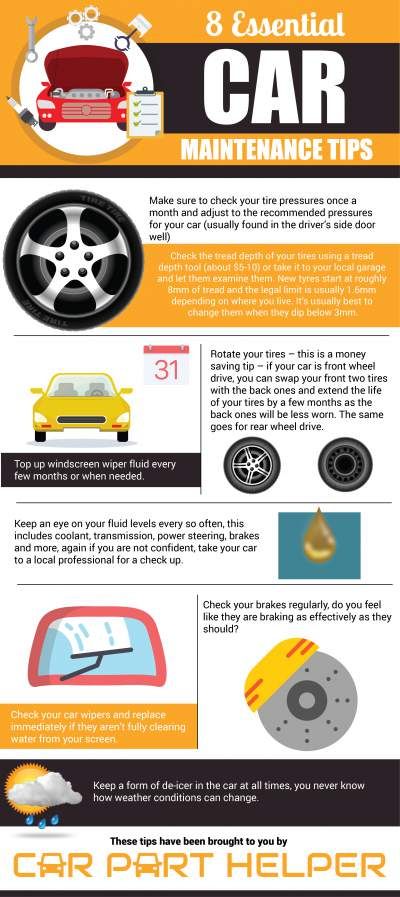We believe everyone should be able to make financial decisions with confidence. And while our site doesn’t feature every company or financial product available on the market, we’re proud that the guidance we offer, the information we provide and the tools we create are objective, independent, straightforward — and free.
So how do we make money? Our partners compensate us. This may influence which products we review and write about (and where those products appear on the site), but it in no way affects our recommendations or advice, which are grounded in thousands of hours of research. Our partners cannot pay us to guarantee favorable reviews of their products or services. Here is a list of our partners.
When the tread depth gets too low or your tires hit the six-year mark, it's time for new rubber.
Many or all of the products featured here are from our partners who compensate us. This may influence which products we write about and where and how the product appears on a page. However, this does not influence our evaluations. Our opinions are our own. Here is a list of our partners and here's how we make money.
While the consensus across the auto industry is that you should consider replacing your tires at least every six years, there’s no magic number for how often you should replace them.
Tires become unsafe when tread becomes too thin, rubber is degraded by time and temperature or their sidewalls are damaged. A flat is an inconvenience, but a blowout or sketchy grip can lead to an accident.
Although tires can be a substantial expense for a car owner to handle at one time, wear and tear — and their replacement — is mostly predictable. Here’s a rundown of how to determine if your tires need to be replaced and common signs that your tires aren’t up to par.
Tires have grooves known as tread that help them grip the road. While most new tires have a tread depth around 10/32nds of an inch, the tread wears down over time. This makes it more difficult to steer your vehicle, reduces traction and increases braking time.
While most new tires have a tread depth around 10/32nds of an inch, the tread wears down over time. This makes it more difficult to steer your vehicle, reduces traction and increases braking time.
The U.S. Department of Transportation deems tires that have tread at or below 2/32nds of an inch to be unsafe. While your tire technically has enough tread to drive at this point, it can be dangerous to drive your car in certain conditions or for long distances.
There are three ways to figure out your tires’ tread depth:
Tread wear indicators are built into tires and are raised, evenly spaced sections in the grooves of your tire tread. On new tires, they are not as high as the tread. However, when the tread reaches the same level as the indicators, it means it’s time to replace the tires.
Tire tread gauges are relatively cheap tools that let you measure your tread in thirty-seconds of an inch. This will show you the exact measurement of your tire tread.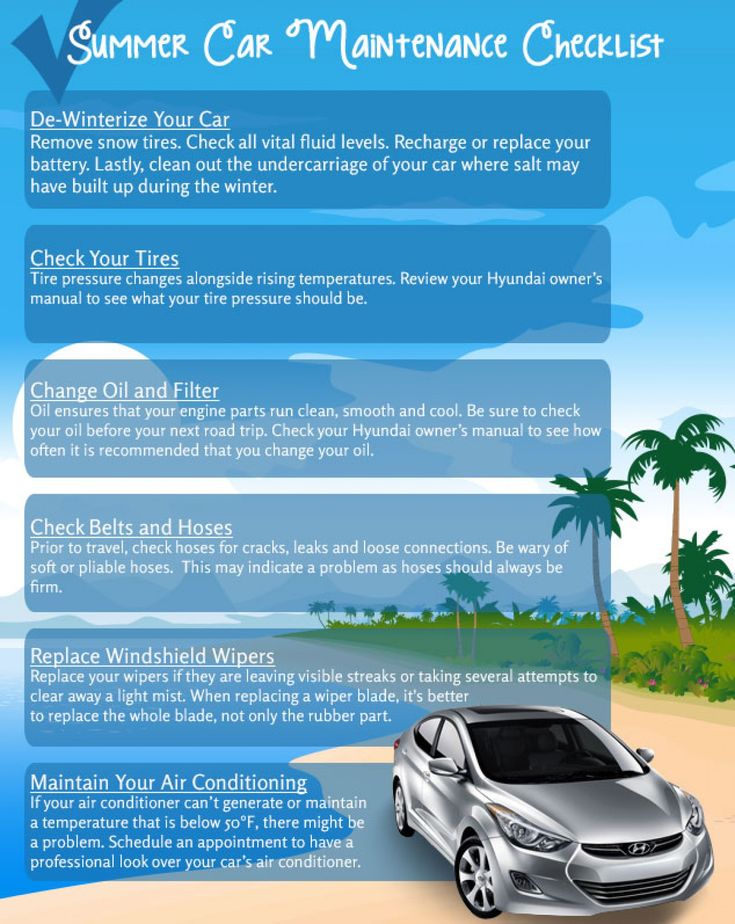
The penny test lets you estimate tread depth based on where the tread hits a penny. To do this test, take a penny, turn it upside-down, and insert it straight down in the groove of a tire’s tread. Look straight on at the penny to determine where the tread hits President Lincoln’s profile. If you can see his entire head, you’ve hit the mark and need new tires.
Regardless of how many miles they’ve driven, tires degrade over time and become more prone to failure. Factors like environmental conditions, storage and maintenance can influence how long a tire will last even if it’s only driven a few hundred miles a month.
While there’s no set requirement for when to replace tires according to age, the general recommendation is to replace them six years after the manufacture date and to never drive on tires that are older than 10 years.
Of course there are other times when your tires are telling you it’s time for replacement despite what your tread measurement might say.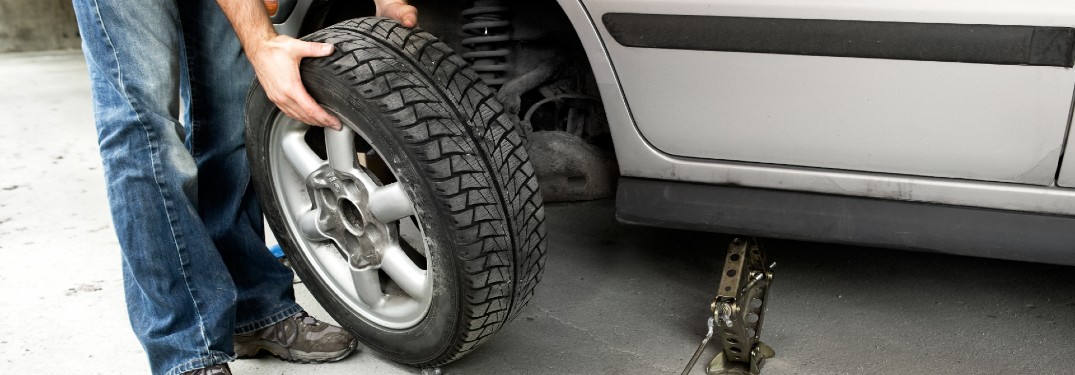
You moved to a new climate. Some tires are designed for specific conditions such as extreme temperatures. Winter tires, for example, have deeper tread and are meant to be more flexible in cold weather; driving them on warm pavement can wear them down more quickly. If you move to a new climate, pay attention to road conditions and weather patterns to determine if you need different tires.
You’re losing traction. If it feels like your car is slipping or sliding during wet weather, this could be a sign of low tire tread that is failing to channel water away effectively. Because tire tread can wear unevenly, you might not notice that some of your tread has worn thin and is affecting your traction.
Most modern cars activate a warning light when your car loses traction. If you are seeing this warning light more frequently as time goes on, check the condition of your tires.
Your tires aren’t holding pressure like they should. Certain types of tire damage, including debris between the rim and the tire and damage to the sidewall, can cause continuous pressure loss.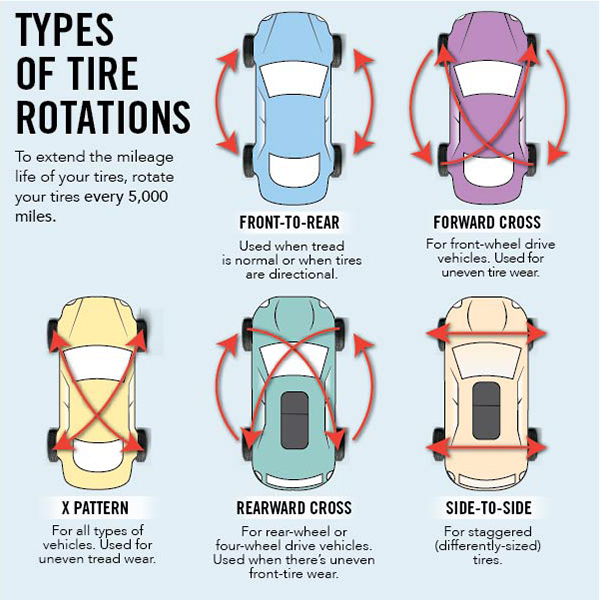 Some damage might be repairable, but some situations will call for new tires.
Some damage might be repairable, but some situations will call for new tires.
🤓Nerdy Tip
An average of 2% air loss in tires is common for every drop of 10 degrees in outside temperature. So don’t worry if your tire pressure varies a bit when it starts to get colder outside.
About the author: Whitney Vandiver is a writer at NerdWallet currently focusing on small business. Read more
On a similar note...
Get more smart money moves – straight to your inbox
Sign up and we’ll send you Nerdy articles about the money topics that matter most to you along with other ways to help you get more from your money.
Do you know when to replace your tires? The good news is gauging the health of your tires isn’t as complicated as you might think. In most cases, figuring out when it’s time for a tire replacement only requires a quick look with a keen eye and maybe the help of a copper penny. You need to know what portions of the tires to look at and what the key tire replacment indicators are.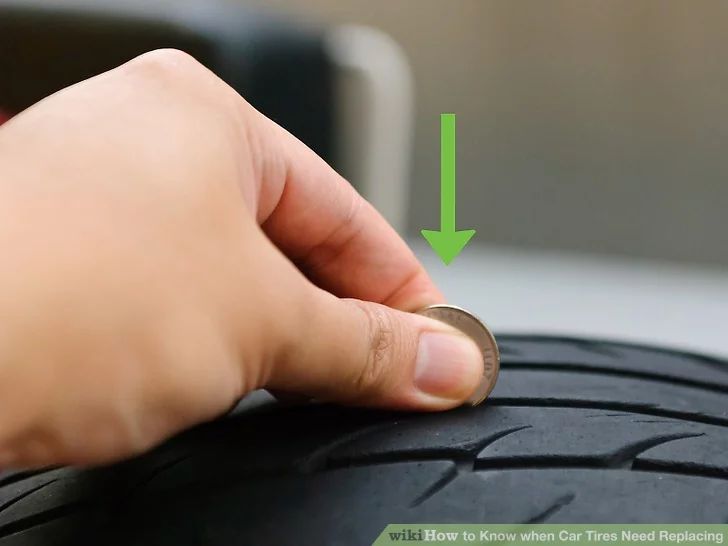 In this guide, we will provide you with all the knowledge you need to accurately assess your tires, determine if they need to be replaced and when, as well as some tips for picking new ones!
In this guide, we will provide you with all the knowledge you need to accurately assess your tires, determine if they need to be replaced and when, as well as some tips for picking new ones!
Here are the three key concerns related to tire replacement:
In this tire replacement guide, we’ll answer these questions and beyond so that you can feel confident you’re replacing your tires with the best choices for your driving needs, local climate and vehicle safety.
The most common question people ask is “How often should you replace your tires?“
Generally, there are two different factors that impact when to replace tires: wear and age.
Tire Wear: All tires eventually begin to experience wear. How the tire wears can be a indication of an issue with your alignment or tire pressure. Tire tread should wear evenly across the whole tire rather than on the inside or outside of the tire. The wear on your tires will happen regardless of how good of a driver you are, although it can be accelerated if you don’t take proper care of the tires.
Tire tread should wear evenly across the whole tire rather than on the inside or outside of the tire. The wear on your tires will happen regardless of how good of a driver you are, although it can be accelerated if you don’t take proper care of the tires.
Tire Age: Tire aging occurs when components of the tire, including the rubber, begin to change over time. This can happen due to environmental impacts and storage conditions, as well as the amount of usage the tire sees when being driven, or the tire sitting with no use.
Image Source: FIHSMV
Of course, unless you’re a tire expert, it can be difficult to know exactly when tire wear and age indicate that a tire is no longer safe to drive and needs to be replaced. If you’re wondering, “How do I know when my tires expire? “ A better question is “How old are my tires and when should I change them?” To answer that question, it’s time to learn how to read your tires!
Every tire has an indication that states when it was made, down to the week and year. This can help you answer the question: how often you should change your tires – even if you’re not an expert on the subject.
This can help you answer the question: how often you should change your tires – even if you’re not an expert on the subject.
Industry standards say you should replace passenger and truck/SUV tires on average at 6 years and before 10 years of age. The timing depends greatly on how the tires have been used and the weather extremes it has been subjected to. How a vehicle has been stored can also impact when a tire needs to be replaced. If your tire passes the penny test, and a visual inspection does not show any cracks or damage, but the tire is 6-10 years old, the wisest course of action is to have them inspected by a tire shop to determine if you need to consider replacing them.
Knowing how often to replace tires isn’t just about taking good care of your vehicle and preventing expensive mistakes. Tires are an extremely important part of your vehicle’s safety.
Worn or old tires can lead to a variety of problems, including:
Additionally, uneven wheel alignments and balance problems will not only cause irregular and premature tire wear, they can cause expensive problems for your vehicle, leaving you dealing with a hefty car repair bill in the future.
Each year, roughly 11,000 tire-related wrecks occur on the road. Don’t blow off tire maintenance as something only “car people” do. Every driver on the road should are about the health and safety of their passengers and vehicles.
Many people ask “How long do tires last on average?“
The problem is, there’s not a set answer to that question – due to the variety of factors that can lead to a necessary tire replacement. These factors include:
Every driver faces different conditions and cares for their cars differently.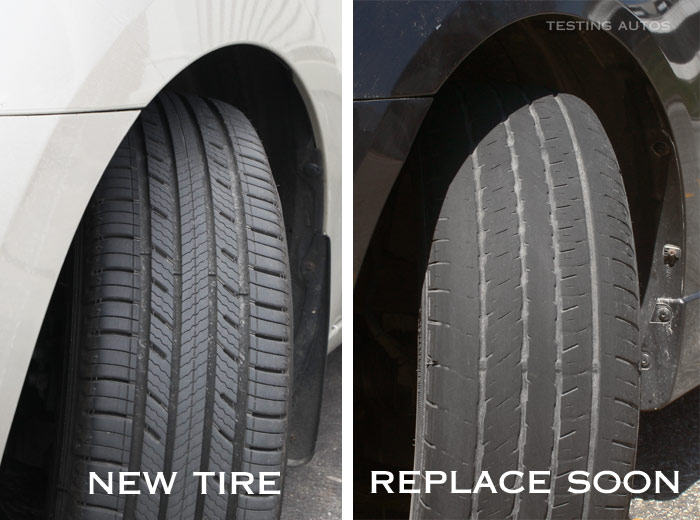 The bottom line is that you need to be aware of your own driving habits, environment, and tires to ensure you’re replacing your tires when necessary.
The bottom line is that you need to be aware of your own driving habits, environment, and tires to ensure you’re replacing your tires when necessary.
The following tips will show you how to tell if tires are worn and need to be replaced soon. Although it is always best to seek professional help with tires, these signs will indicate that you should begin researching new tires for your car.
 Any tires with sidewall bulges or bubbles should be replaced immediately, even if the tread status is acceptable.
Any tires with sidewall bulges or bubbles should be replaced immediately, even if the tread status is acceptable.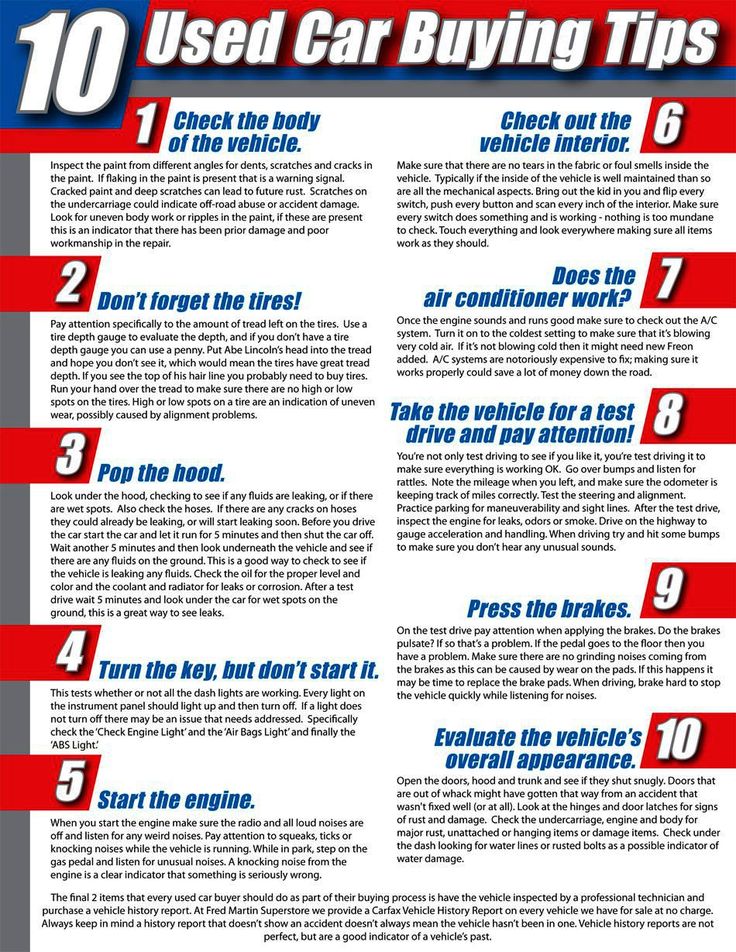 Obviously, if something is lodged in the tire, the issue needs to be addressed immediately. Even if the hole isn’t causing excessive leaking, ignoring a hole from something like a nail can lead to problems for the driver later on. Moisture can leak into the tire, causing the steel parts to rust. Lodged items can weaken the area of the tire and possibly lead to dangerous blowouts if not dealt with in a timely manner.
Obviously, if something is lodged in the tire, the issue needs to be addressed immediately. Even if the hole isn’t causing excessive leaking, ignoring a hole from something like a nail can lead to problems for the driver later on. Moisture can leak into the tire, causing the steel parts to rust. Lodged items can weaken the area of the tire and possibly lead to dangerous blowouts if not dealt with in a timely manner.After you have figured out when to change tires, you’ll find that selecting replacement tires a bit of a process. You’ll need to start by assessing your driving habits, the types of terrain and seasons you will be driving in, to determine what you need in a tire. You should also evaluate how well you feel your current tires performed in longevity, handling, ride, noise and any other category you have noticed.
You’ll need to start by assessing your driving habits, the types of terrain and seasons you will be driving in, to determine what you need in a tire. You should also evaluate how well you feel your current tires performed in longevity, handling, ride, noise and any other category you have noticed.
After that, you’ll be able to match your driving style to the perfect tire type. To help jumpstart your research, here are a handful of the most popular tire categories, seasonal applications, and the features that make them great fits for particular drivers’ needs.
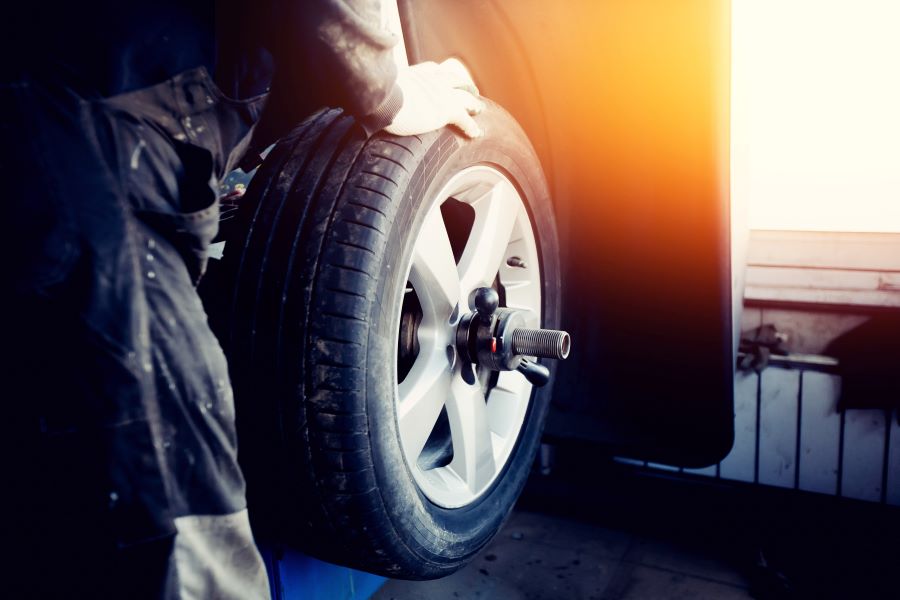
 They can be driven in both the summertime and the wintertime.
They can be driven in both the summertime and the wintertime.Before you decide which tire you need, think about what kind of driving you do. If you drive primarily on the highway and city streets, you may need a highway or touring tire. On the other hand, if you typically drive on back roads AND need on-pavement capability, an all-terrain might be your best bet.
If you drive primarily on the highway and city streets, you may need a highway or touring tire. On the other hand, if you typically drive on back roads AND need on-pavement capability, an all-terrain might be your best bet.
If you face severe winter weather during certain points of the year, you will likely need to upgrade to a tire that can handle those conditions.
First pick the category of the tire to fit your driving needs, then decide on the season that best suits the climate you live in.
The NHTSA has rated more than 2,400 tire lines. You can use the official NHTSA website to check out the details on specific tires.
The treadwear grade rates how well a tire compares to others in a specific test. A tire with a grade of 3000 wears three times as long as a tire that only has a grade of 100. However, you should keep in mind that different driving styles, road conditions, and levels of maintenance can also impact treadwear.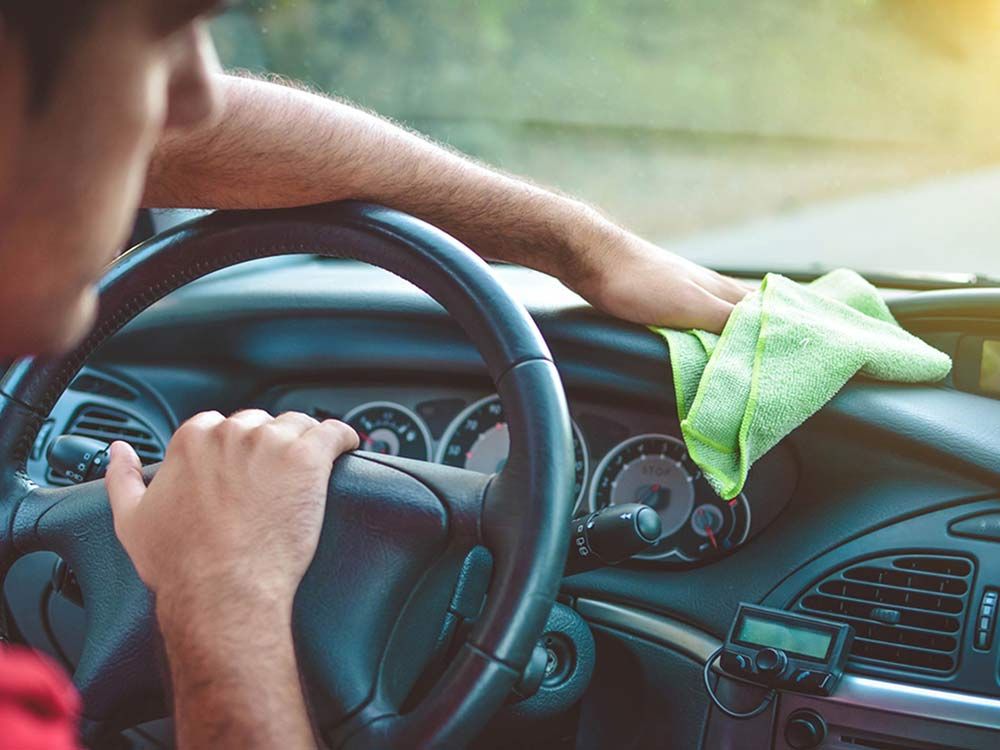
This refers to the tire’s ability to stop on different kinds of surfaces, including asphalt and concrete. AA is the best rating a tire can receive, followed by A, B, and then C.
The temperature rating indicates the tire’s resistance to heat. A is the highest rating, followed by B and then C.
Some people, in an effort to save money upfront on the tire replacement cost, turn to old (used) tires as replacements. However, this can be a risky strategy, even if it does save money initially.
Here are some of the issues you can face when buying second-hand tires as replacements.
Last but not least, people generally don’t pay attention to their spares as they decide when to get tires replaced. Because the spare isn’t used much, people assume that it doesn’t experience wear or tear and that it doesn’t need to be replaced.
Because the spare isn’t used much, people assume that it doesn’t experience wear or tear and that it doesn’t need to be replaced.
However, even spare tires need to be replaced after a certain amount of time. Be sure to check the date of production on the spare before deciding not to replace it. If you’re not sure how to check the date of your tire, refer to our post on DOT Date Code.
Don’t forget to pay attention to visible kinds of age as well. Just because a tire hasn’t really been used doesn’t necessarily mean it stays protected from cracks or cuts, as well as other problems that come with age including:
Whether a tire has been driven or not, its lifespan can be affected by its storage condition and treatment. If you know you will be parking your vehicle for a period of time, it is a good idea to protect the tires from sun and freezing temperatures, move the vehicle periodically to prevent flat spots, and even jack the vehicle up safety to prevent damage. If you are storing winter or summer tires, it is best to store them in a cool, dry location away from sun and other weather elements.
To sum things up, here’s a list of the most frequently asked questions, as well as some brief answers to steer you in the right direction when replacing your tires.
Although this answer does depend on a number of factors including the type of car, your driving style, etc., there is an average estimate for how often you should change your tire. In general, most vehicles travel about 15,000 miles per year, which equates to around 45,000 miles every three years. If you to take into account the tire mileage warranty and amount you drive over the course of a year (over 15k miles), this will give you a good indication of how often you will need to replace your tires.
This is a topic of much debate. However you will find most vehicles, regardless of if they are front wheel drive or all wheel drive, will wear the tires on the front more rapidly than the rear. The front tires are responsible for the steering, acceleration and braking, while the rear wheels typically just follow. Most vehicles also have most of their weight on the front of the vehicle, causing the front tires to handle more load than the back tires.Since the wear and tear on the front and back wheels can be different, the answer to which tires wear faster, is typically the front tires.
The front tires are responsible for the steering, acceleration and braking, while the rear wheels typically just follow. Most vehicles also have most of their weight on the front of the vehicle, causing the front tires to handle more load than the back tires.Since the wear and tear on the front and back wheels can be different, the answer to which tires wear faster, is typically the front tires.
All-wheel drive vehicles must have all four tires replaced at once. You don’t have the option to replace just two at a time.
Because tires wear unevenly front to back, regular rotations will allow you to get longer use out of your set of tires by wearing the tread more evenly. Front tires will wear the outside edges down more quickly, so rotation allows you to always have the most tread on the outside of the tire. Not rotating will result in one set of tires wearing and likely needing to be replaced sooner than the other set.
First things first: check your vehicle’s owner’s manual to see if it has a recommended rotation scheme. Tires should be rotated roughly every six months or every 6,000 to 8,000 miles. A good rule of thumb is to rotate the tires every other time you get an oil change.
Tires should be rotated roughly every six months or every 6,000 to 8,000 miles. A good rule of thumb is to rotate the tires every other time you get an oil change.
Placing a penny head into the grooves of your tire can help you determine if the tire needs to be replaced soon. If you can see the top of Lincoln’s head, your tires are likely shallow and worn. Use this as an indication of when you should have a tire professional examine the situation.
If you are replacing only one pair of the tires on your vehicle, these new tires will have a deeper tread depth. Be sure to install the new tires onto the rear axle for better control when driving on wet and winter roads.
Ideally, you need to replace two tires with matching new ones. However, the most important thing is to install tires with similar performance features. For example, you should never put two high-performance tires with two touring tires.
Generally, it’s smart to replace tires in pairs (both in the front or in the back). Although replacing all four at once is the easiest, if you need to save money, you can do one pair at a time. If you’re wondering “can I replace just one tire?“ the answer is typically no. The difference in tread depth and stance can throw off your vehicle’s performance.
Most tire sellers would likely recommend that you avoid mixing tires from different categories. They can be different brands, as long as the internal construction and size are the same – but pay close attention to the stance of the tires and be sure they are very closely matched
Nope! Just make sure that all of the tires are evenly matched and appropriate for your vehicle and your driving habits.
It’s difficult to give a firm answer to this question.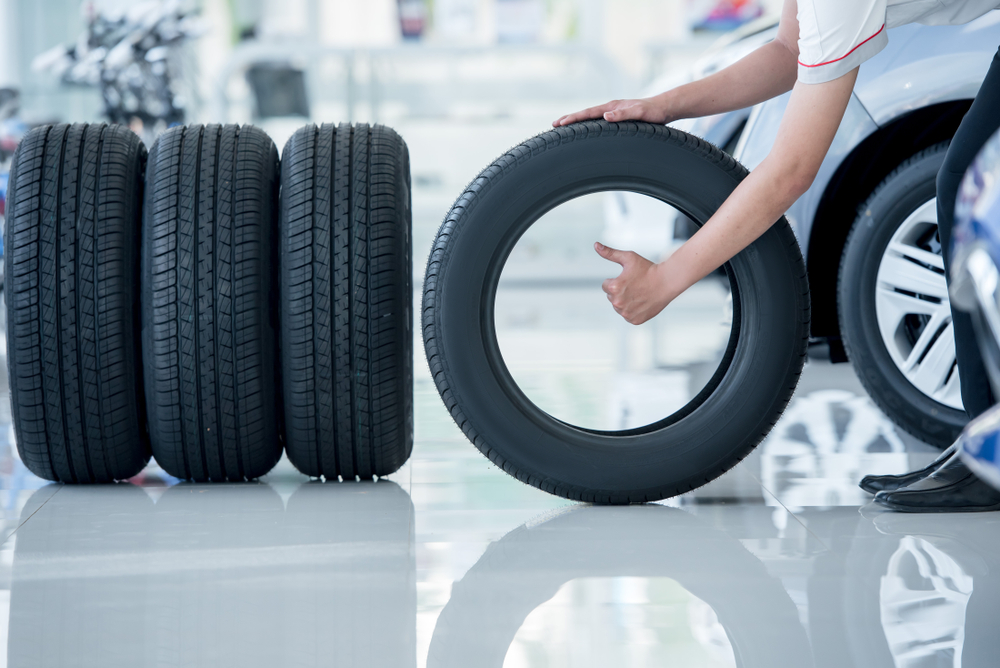 Generally, most tires typically last for three to five years. That’s when roughly 12,000 to 15,000 miles are put on the car annually.
Generally, most tires typically last for three to five years. That’s when roughly 12,000 to 15,000 miles are put on the car annually.
The best things to do to make your tires last as long as possible are:
Once you get your new tires installed, take it easy on the road for a while to break the tires in. New tires may feel different than the tires you replaced, since they are likely performing better than a worn tire, and have the latest technology.
Also, if you changed categories of tires, you might experience a big change in the feel of your drive. For example, switching from an highway to an all-terrain tire might change the roughness and noise of your drive, as well as your fuel consumption.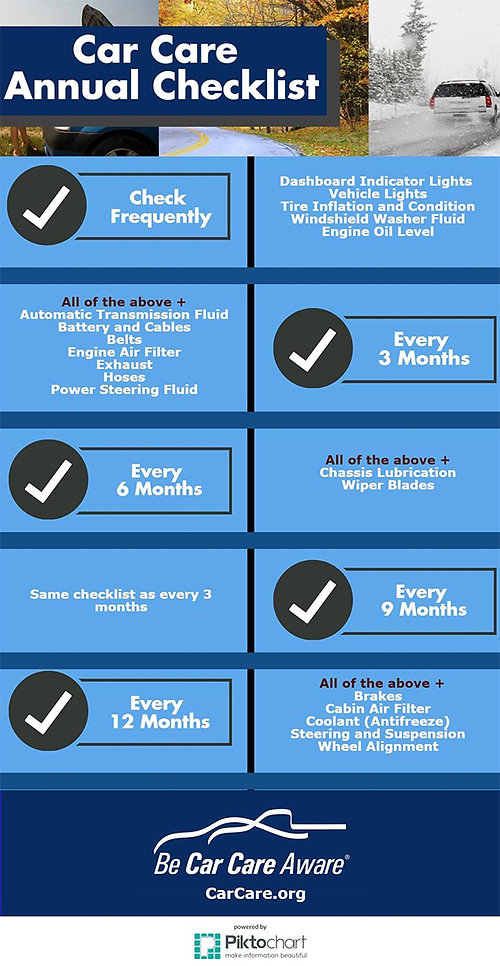
Deciding when to replace your tires is an important decision, both for the safety of your vehicle and that of others. Use the above guide to steer you in the right direction and help determine exactly when you should make the switch to brand new tires.
Additionally, deciding what to replace is important. You can increase (as well as decrease) the comfort, fuel efficiency, noise, tread wear, or other aspects based on the decisions you make with new tires.
Join Today For Free
0003Related materials
7 rubber signals: what the tire says about car problems
How do you know when tires are completely worn out and it's time to change them? Everything is simple. For summer tires, the limit is 1.6 mm of residual tread depth, and for winter (or all-season tires used in winter) - 4 mm. Modern summer tires can travel from 40,000 to 70,000 km, depending on driving style and vehicle characteristics.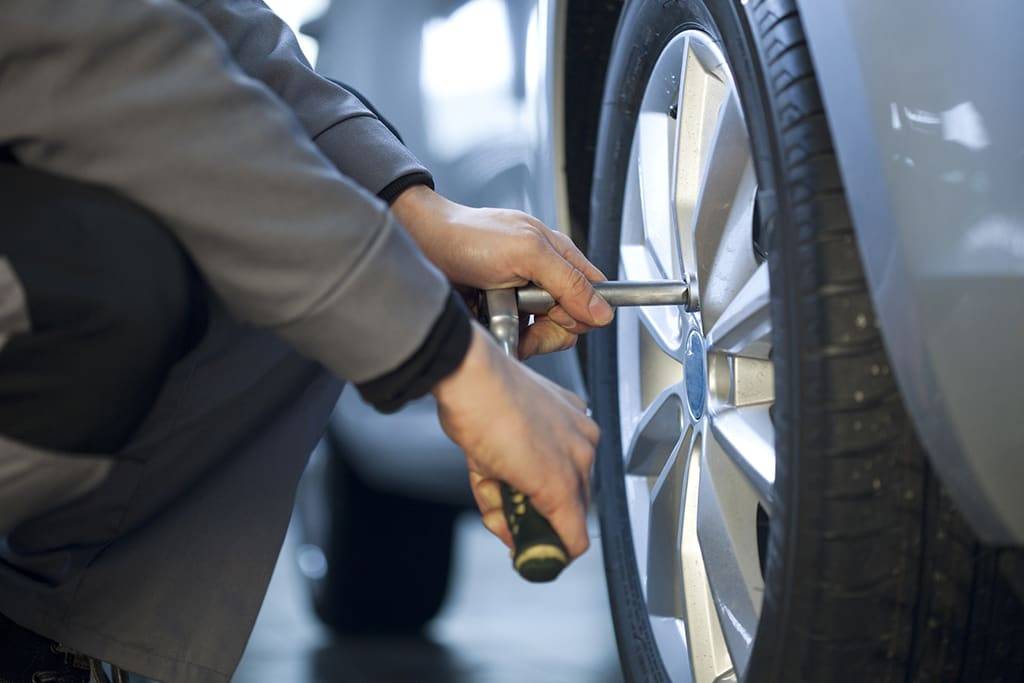 An average motorist rolls such a mileage on summer tires in 2-3 seasons. Moreover, wear implies not only a decrease in tread depth. For millions of cycles of deformation, the strength of the carcass and its adhesion to the layers of the rubber compound are violated. In short, every 2-3 years you should buy a new set of tires.
An average motorist rolls such a mileage on summer tires in 2-3 seasons. Moreover, wear implies not only a decrease in tread depth. For millions of cycles of deformation, the strength of the carcass and its adhesion to the layers of the rubber compound are violated. In short, every 2-3 years you should buy a new set of tires.
In case of irreparable damage to one of the tires and a relatively high total mileage of the kit, it is also worth considering replacing it. Well, or about buying at least a pair of new tires, which, for any type of drive, should be installed on the front axle. We put two tires back - the most decent of the remaining ones.
Many motorists drive only a few thousand kilometers a year. This does not mean that the tires will serve you for several decades. According to Russian requirements (GOST 4754-97), the service life of passenger car tires is 5 years from the date of manufacture. And for example, Continental recommends that all car tires (including the spare tire) older than 10 years old should be replaced with new ones.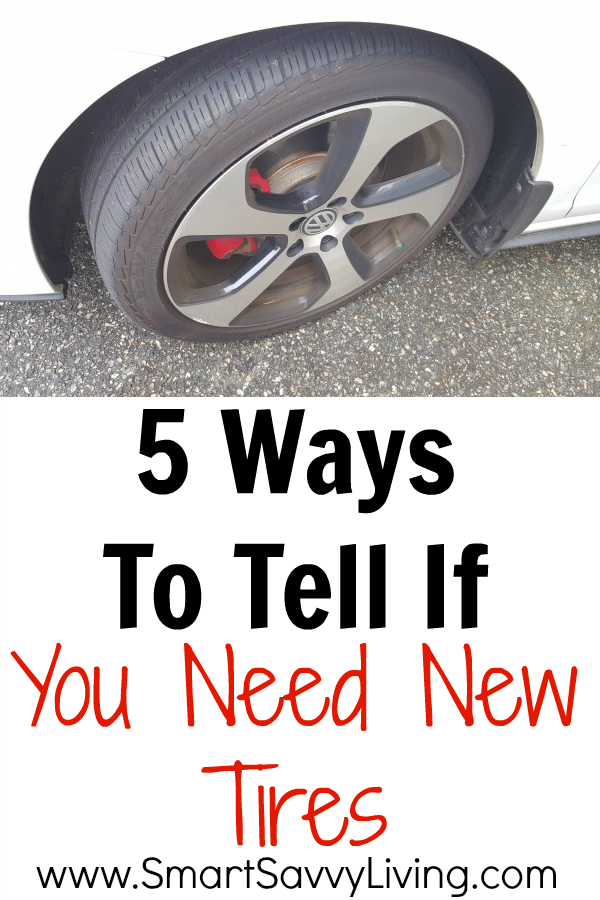 Therefore, with small runs, you can navigate for ten years. The date of manufacture of the tire is indicated on the sidewall. Usually it is an oval with four numbers. The first two are the ordinal number of the week in the year, the last two indicate the year.
Therefore, with small runs, you can navigate for ten years. The date of manufacture of the tire is indicated on the sidewall. Usually it is an oval with four numbers. The first two are the ordinal number of the week in the year, the last two indicate the year.
Related materials
How to change the car yourself - detailed instructions
Tires should be rotated periodically in accordance with the vehicle manufacturer's recommendations - information on this can be found in the owner's manual.
We can advise you to carefully use the tires and, most importantly, to store them correctly in the off-season. First of all, during storage, it is important to exclude direct sunlight from hitting the tires, which greatly age the rubber. Tires without rims should be placed vertically, and stacked on rims.
And before installing tires on a car at the beginning of the season, evaluate their condition.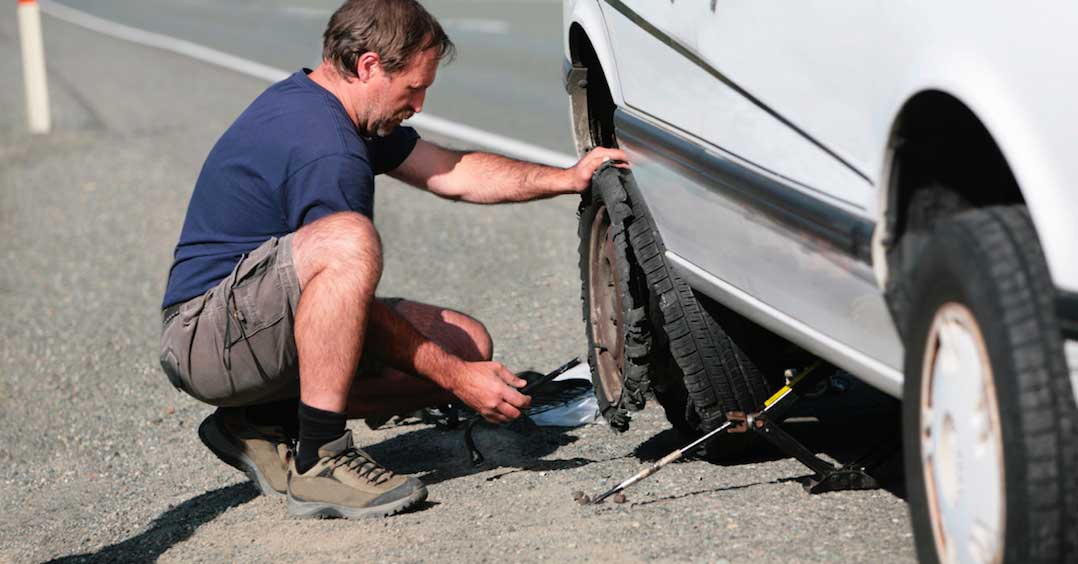 There should be no cracks in the tread and sidewalls. The tire should not be dry, it should remain rubbery and not look like baked plastic.
There should be no cracks in the tread and sidewalls. The tire should not be dry, it should remain rubbery and not look like baked plastic.
Related materials
Driving on badly worn tires - will I be fined or not?
Winter tires have a much shorter life span. They almost always fail due to the wear of the treadmill, because the tread of a new tire is 7–8 mm, and only 3–4 mm remain working height. If the tires are studded, then with such wear there are very few metal elements left, and the tire will not provide adequate safety when driving on a winter road. However, not only spikes, but also Velcro, with such a degree of wear, also lose most of their capabilities.
The real life of winter tires rarely exceeds 30,000 km. "Bald" winter tires without studs can be re-rolled in summer, but their grip on hot road surfaces will be very poor. This must be taken into account, especially when braking.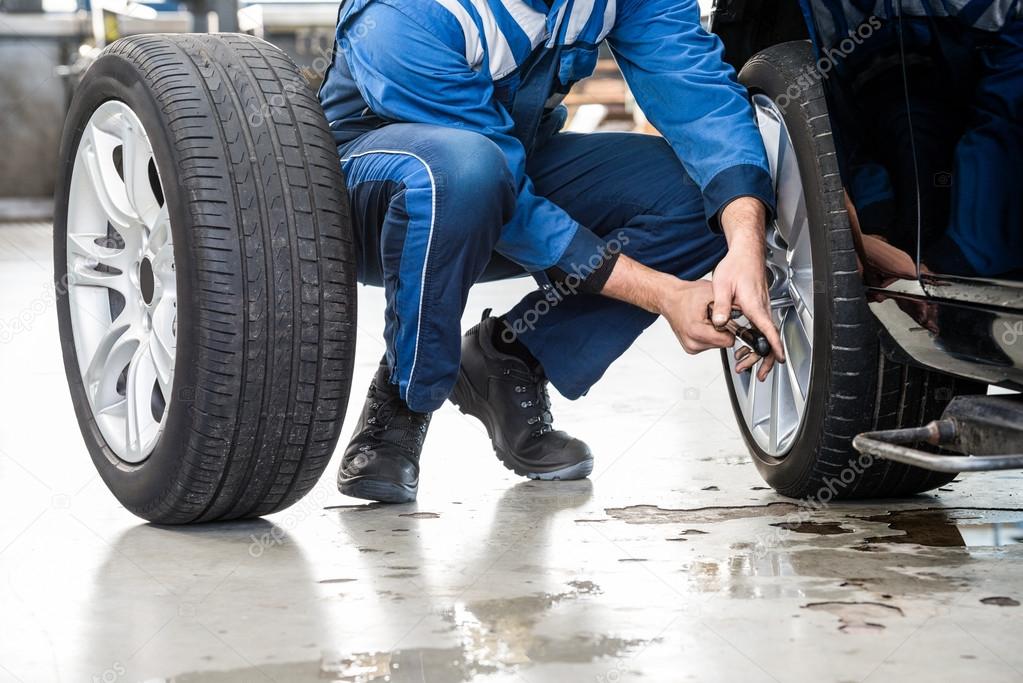
***
So: tires that have not yet worn out along the tread (that is, up to 1.6 mm tread depth for summer tires, 4 mm for winter tires) are changed either ten years after the date of issue, or when the rubber layer cracks tires or damage.
Our new video
An interesting (and inexpensive) car from Lipetsk: everything is different here!
Test of the most affordable (well, almost) crossover for the family
Test of the new Chinese crossover Skywell ET5
Like this post? Subscribe and you will always be in the know!
Driving on Yandex.Zen
News smi2.ru
Konstantin Ishchenko
experienced motorist
Much depends on the condition of the suspension, springs and shock absorbers, but tires provide direct grip on the road.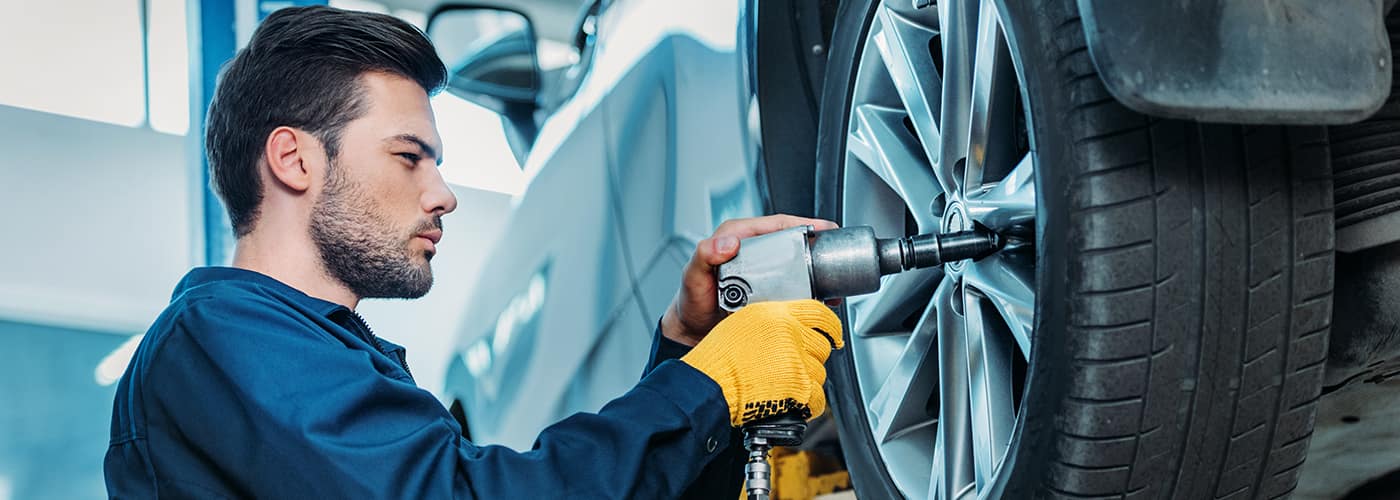 Wrong or worn tires can cause accidents. In this article, we will tell you how to avoid this.
Wrong or worn tires can cause accidents. In this article, we will tell you how to avoid this.
In spring - from winter to summer. There are no strict requirements in the regulatory documents: it is recommended to use winter tires from December to February, and summer tires from June to August. There are requirements for studded tires: they cannot be used from the first of June - for this they can be warned or fined 500 R. From winter to summer, they change shoes at an average daily temperature above +7 ° C. After this mark, winter tires wear out quickly and hold the road poorly.
There are requirements for studded tires: they cannot be used from the first of June - for this they can be warned or fined 500 R. From winter to summer, they change shoes at an average daily temperature above +7 ° C. After this mark, winter tires wear out quickly and hold the road poorly.
Rules of the Customs Union "On the safety of wheeled vehicles"
In autumn — from summer to winter. It's time to change tires if the average daily temperature drops below +10 °C: summer tires become dull, grip becomes worse. In autumn, it is much more difficult to sign up for a tire fitting: the closer the frost, the longer the appointment. People are afraid of ice, the prospect of hitting someone else's car or flying into a ditch.
What to do? 02/21/20
Wheels scratched in my car service
Car tires are a consumable item. In addition to seasonal replacement, it is important to replace them as soon as they are worn out or seriously damaged.
When the tire is worn. Each car tire has a wear indicator - a special jumper between the tread islands. As soon as the tread wears off and matches the level of at least one of the indicator jumpers, it's time to change the tire. Such a tire is dangerous, especially on wet surfaces.
/carservice/
How to save on the operation of the machine
Insufficiently high tread poorly removes water from the contact patch of the tire with the roadway. Where you can confidently drive 70–80 km/h on new tires, on worn tires you can lose control of the car already at a speed of 55–60 km/h.
Indicator bar on a tire that has been through a season and a halfSome manufacturers apply their own wear indicators in addition to the standard ones. For example, on Nokian tires, numbers are cut in the middle of the tread: the larger the number, the deeper the cut.
A relatively new tire will have a lot of numbers, a worn one or two will remain - the rest will be erased.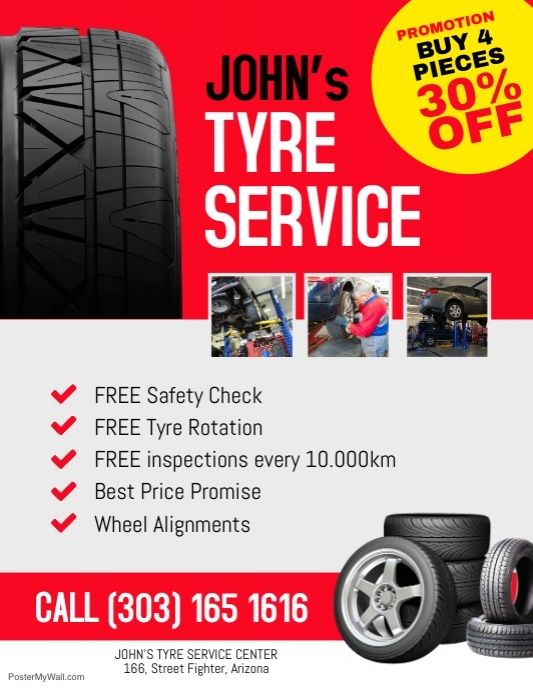 A drop with a cross is applied to the sidewall of the Continental tire. As soon as it is worn down to half, the tire should be considered worn out and replaced. But all these are rather exceptions - most tires do not have such indicators.
A drop with a cross is applied to the sidewall of the Continental tire. As soon as it is worn down to half, the tire should be considered worn out and replaced. But all these are rather exceptions - most tires do not have such indicators.
Wear may be uneven. If the tire has been inflated, the center of the tread will be worn off. If the tire pressure was too low, it will be relatively fresh and the sidewalls of the tread will be worn out.
Non-standard wear indicators. From left to right: Nokian with numbers - summer and winter, Continental summer - with a drop and a cross Tire that was pumped over: wear on the central part of the tread is much strongerIt also happens that either the inner or outer side of the tread wears out on one wheel. This means that the camber is broken - the angle of the wheel relative to the vertical plane. In this case, it is important to sign up for wheel alignment - this is a service during which the wheel alignment angles are adjusted.
It happens that the angles of the wheels are not adjusted.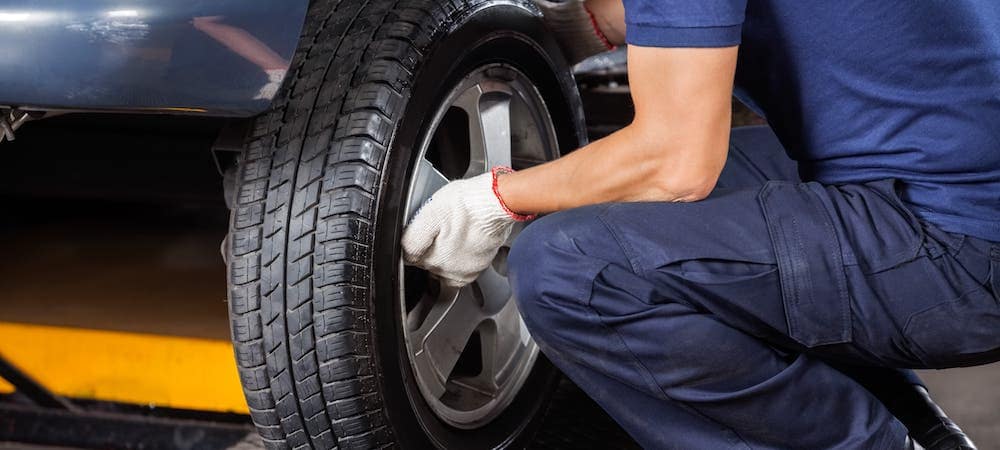 For example, if the car has been in a serious accident and its power parts of the body or suspension parts are deformed. In this case, you will have to eliminate these malfunctions, and then go to the wheel alignment stand again.
For example, if the car has been in a serious accident and its power parts of the body or suspension parts are deformed. In this case, you will have to eliminate these malfunctions, and then go to the wheel alignment stand again.
/sud-autoservice/
As I sued the auto service
Sawtooth or comb wear occurs on winter tires if the toe-in is broken - the angle of the wheel position in the horizontal plane. Sign up for a wheel alignment so that the same wear does not appear on the new tire.
Uneven tread wear. The tire was on a wheel with unadjusted camber Comb-shaped tread wear. Source: mashintop.ru When the tire is damaged and it is noticeable. It’s easy enough to damage a tire: cut the sidewall, run into a piece of reinforcement or get hit, in place of which a hernia will come out. All sidewall damage is a good reason to buy a new tire: repairs will be expensive and ineffective. Damage to the working part of the tire - the tread - is less critical.
When damage is present but not visible. Hidden damage may appear on the back of the wheel. For example, a driver caught a hole, felt a good hit, got out, saw that everything was in order, and drove on. And on the reverse side, a piece of rubber was torn out and the cord became visible - the metal carcass of the tire. Such damages are found only when inspecting the chassis or at a tire fitting, and this is bad: they can cause an accident or serious damage to the car.
Service life of car tires. The tire life recommended by most manufacturers is five years, but this does not mean that they cannot be used for the sixth year. The expiration date is not limited by any documents.
GOST R 52900-2007
Tire manufacturers estimate tire service life differently. Nokian provided the most detailed explanation: “Tire life is not defined by law, but tires can only be considered new if they have been manufactured within the last five years.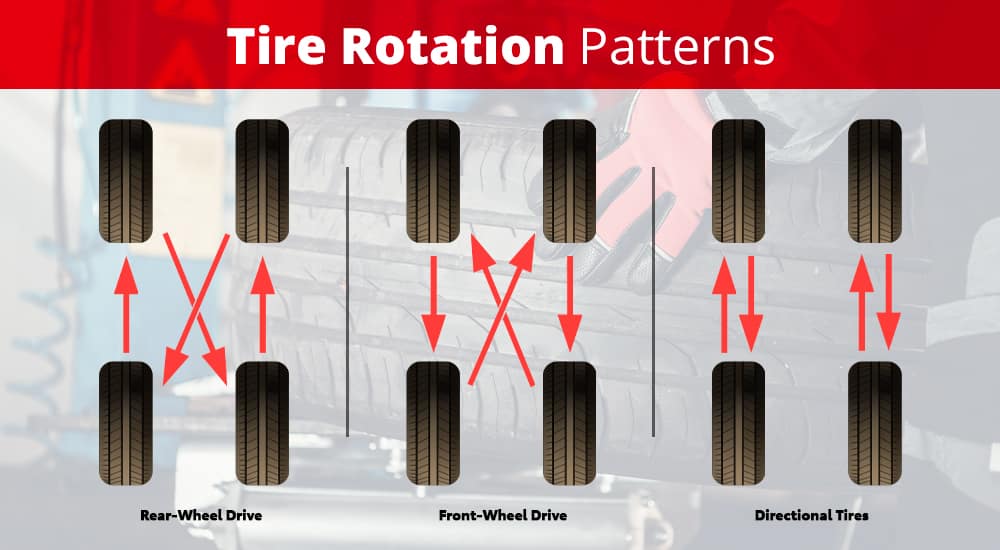 The recommended tire life is 6 years and the maximum is 10 years. Then the tire loses its consumer properties: grip deteriorates, vibration may appear on the body or steering wheel.
The recommended tire life is 6 years and the maximum is 10 years. Then the tire loses its consumer properties: grip deteriorates, vibration may appear on the body or steering wheel.
5 years
tire life recommended by most tire manufacturers
Storage location - less than a meter away from direct sunlight and heaters. In the sun, near the battery and in the rain, the tire will quickly lose its properties: the rubber will dry out and collapse. Permissible temperature - from -30 to +35 ° C, humidity - 50-80%. Do not leave the wheels dirty; they must be thoroughly washed before seasonal storage. Tires can be stored under a canopy in the open air for no more than a month.
GOST 54266-2010
The method of storage depends on the set: either tires separately or wheels as an assembly. Tires up to 205 mm wide can be stored in even stacks up to 2 m high. Tires from 210 mm are stored vertically - on edge. Every three months, all tires, regardless of width, should be rotated to change the footprint.
Every three months, all tires, regardless of width, should be rotated to change the footprint.
GOST does not explain how to store the wheels as an assembly, but Nokian has a visual manual for storage. Continental recommends hanging wheels by rims or storing them in a stack, similar to tires, turning them over every 4 weeks. It is advisable to reduce the air pressure in the tire to 1-1.5 atm and not make stacks of wheels - a tire plus a disk - more than four pieces.
Nokian Tire Storage TipsPDF, 2.1 MB
Featured Articles for Motorists
How to drive without fines and not overpay for car maintenance - in our newsletter along with other materials about money
First of all, you need to decide which tires are suitable. All important characteristics are written on the sidewall of the tire.
It is important to consider the dimensions of the tire when selecting it for a specific car and rim. All options provided for by the design of the car are written on special plates.
All options provided for by the design of the car are written on special plates.
Depending on the brand of car, they can be found on the gas tank flap or on the B-pillar in the driver's doorway. The recommended tire pressure is also written here.
/usedcar/
How to buy a used car
Decal with Mini John Cooper Works tire parameters in the doorway: size and recommended pressure at different loads Decal on the gas tank flap of the Skoda OctaviaTire sizes are indicated in the format xxx/xx Rx. They are on the sidewall of the tire.
The first parameter is the tread width in mm. The size step is 10 mm, always 5 at the end. Next is the tire profile, or its height as a percentage relative to the width. The width of a tire with parameters 235/55/R16 is approximately 129 mm, and for a tire 195/55/R16 it is 107 mm.
R - an indication of the type of tire, in this case, that it is radial. There are also diagonal ones, but this is an outdated design.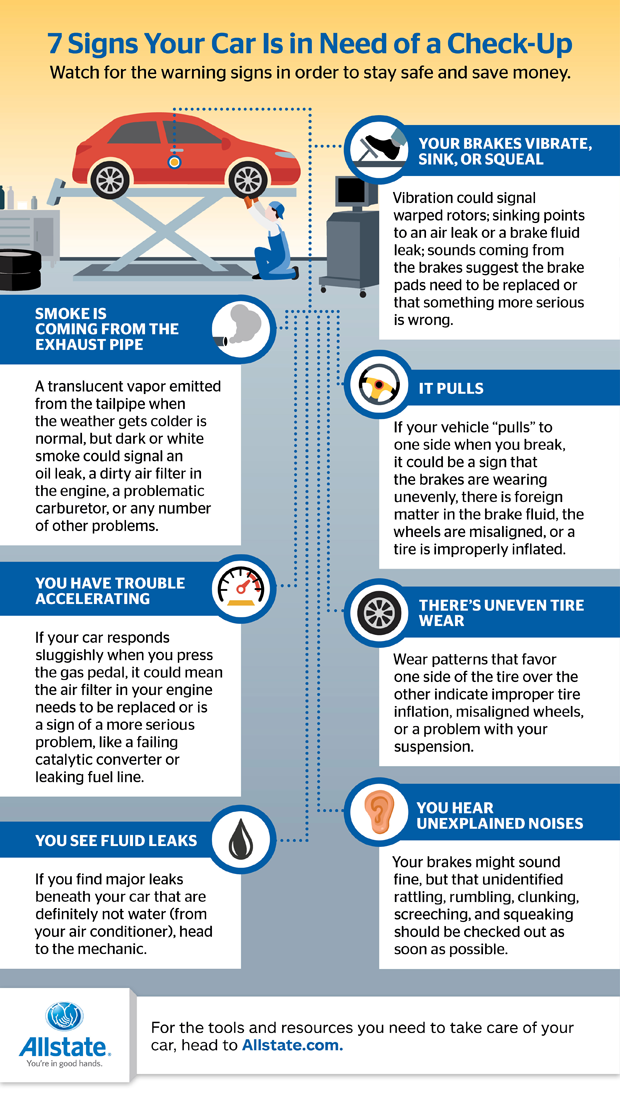 These have not been used for cars for a long time. The difference is in the design of the cord. A popular misconception is that R is a radius.
These have not been used for cars for a long time. The difference is in the design of the cord. A popular misconception is that R is a radius.
The last two digits are the diameter of the rim in inches, on which the tire can be placed.
It is undesirable to deviate from the tire parameters recommended by the car manufacturer. This can adversely affect handling, as well as cause the tire to rub against the wheel arch or suspension parts: this will damage the tire and increase the likelihood of an accident.
It happens that on the front and rear axles from the factory there are disks for rubber of different sizes. Usually we are talking about the width - the rear wheels can be wider than the front. In the people, such a set of disks is called a different-wide one.
Tube or tubeless construction. Previously, a car wheel consisted of three main parts: a disc, a tube, and a tire. The tire was responsible only for traction and overall strength, the chamber was a container for air. This design had serious drawbacks:
This design had serious drawbacks:
Now you can find a tube tire on a car only in a museum or in your grandfather's garage: the technology is outdated.
Modern tubeless tires do not have these drawbacks. Special protrusions in the disks — hubs, for which the tire clings, help to maintain the tightness of the tubeless wheel.
Manufacturers still mark tubeless tires with a special tubeless mark, and those intended for use with a tube - tube type, but now these are only rare domestic models Cord construction type. Each tire is multi-layered, a single rubber product will not be able to provide the desired shape and strength. Therefore, inside the tire there is a cord - a kind of carcass. The cord can be metal, synthetic fibers or textile threads. According to the method of laying the cord, tires are divided into radial and diagonal.
The cord can be metal, synthetic fibers or textile threads. According to the method of laying the cord, tires are divided into radial and diagonal.
| Bias tire | Radial tire |
|---|---|
| 2 or more cords | 1 ply cord |
| Smaller contact patch | Larger road contact patch |
| Tire heavier than | Lighter tire |
| Used on commercial vehicles | Used on passenger cars |
| Cheaper than | Expensive |
Bias
radial tire
2 layers of cord or more than
1 layer of cord
Less contact stain with an expensive
SPECTION with an expensive
tire
tires easier than
are used on commercial equipment
used on cars
Cheaper
More expensive
Radial tire cords are parallel to the wheel circumference, on top of each other. For diagonal tires, the cord layers overlap each other diagonally. Source: Kolobox
For diagonal tires, the cord layers overlap each other diagonally. Source: Kolobox DOT marking. The name comes from the American Department of Transportation - an analogue of our Department of Transportation. In 1978, this department approved mandatory labeling for all automobile tires, which includes Treadwear, Traction, and Temperature grades marked on the sidewall. Now most manufacturers use this system, selling tires without such marking is illegal in the USA.
Treadwear. Some people want tires to last as long as possible, others want good grip. So far, these qualities have not been learned to combine in one tire.
The wear rate of a tire is indicated by the Treadwear index. Typically, for products for passenger cars, this parameter ranges from 100 to 600. In terms of kilometers, this is approximately 10,000-15,000 km per hundred points. For example, index 240 corresponds to 24,000-36,000 km.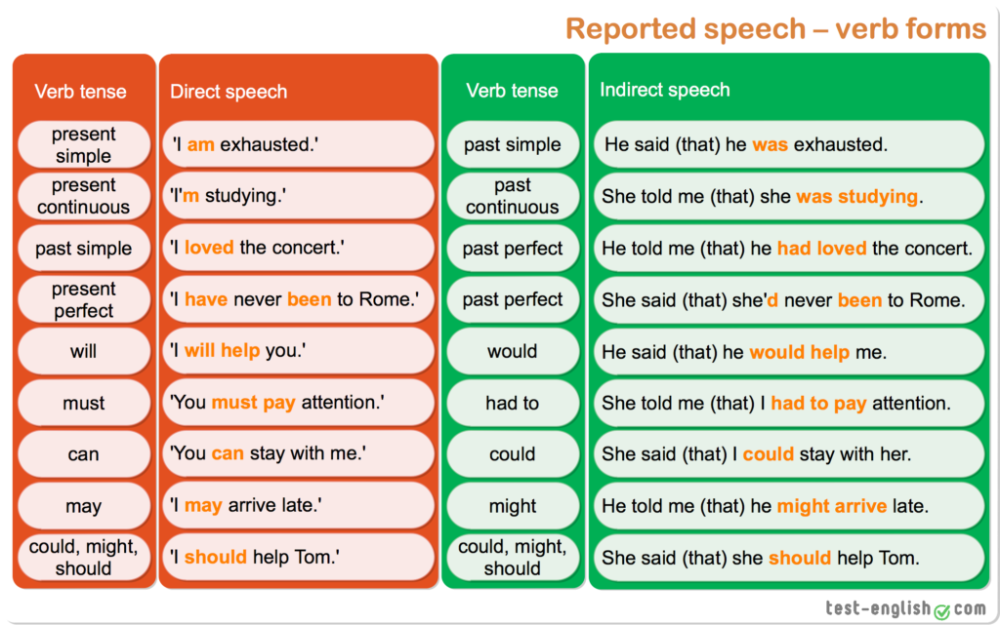 At the end of the range there will be tires that were used with a calm driving style.
At the end of the range there will be tires that were used with a calm driving style.
Traction also shows the grip class, but unlike Russian traffic rules and technical regulations, the classification is based not on distance in meters, but on the deceleration coefficient - G, which the tire can provide. According to Traction, all tires are divided into classes according to their ability to effectively stop a car on wet asphalt and concrete: from the best AA to the worst C.
| Class | G on asphalt | G on concrete |
|---|---|---|
| AA | More than 0.54 m/s² | 0.38 m/s² |
| A | More than 0.47 m/s² | 0.35 m/s² |
| B | More than 0.38 m/s² | 0.26 m/s² |
| C | Less than 0.38 m/s² | 0.26 m/s² |
Class AA
G on asphalt
More than 0. 54 m/s²
54 m/s²
G on concrete
0.38 m/s²
class A
G on the asphalt
more than 0.47 m/s²
G on concrete
0.35 m/s²
Class B
G on asphalt
more than 0.38 more m/s²
G on concrete
0.26 m/s²
Class C
G on asphalt
less than 0.38 m/s²
G on concrete
0.26 m/s²
Temperature characteristic, Temperature. All tires are divided into three classes according to the resistance to heat generation during movement: A, B and C. Class A tires effectively remove heat at speeds over 185 km / h, class B - from 160 to 185 km / h, class C - from 137 up to 160 km/h. For passenger cars, there are almost no tires on sale, except for class A.
Run flat. This rubber has a thick and stiff sidewall. It can be driven up to 80 km at speeds up to 80 km/h after a puncture or side cut with a complete loss of pressure.
It is important that the machine is equipped with a tire pressure system, otherwise the driver may not recognize a flat tire, exceed the recommended speed, or drive more than 80 km, which at best will lead to damage to the rim, and at worst, to an accident.
Many vehicles come with runflat tires from the factory. Especially on those who do not have a spare tire. Such tires are 1.5-2 times more expensive than ordinary ones, they make driving less comfortable: due to the hard sidewall, such rubber smooths out bumps much worse and is heavier than conventional tires.
But you don't have to call a tow truck: you can almost always get to the tire shop on your own. If you drive on a relatively flat road, there will be no damage to the alloy wheel: it is still a few centimeters from the road surface.
/otozvali/
How to repair a car under a recall campaign
Load and maximum speed indices. Load Index is a two- or three-digit number that indicates the maximum weight that a tire can support. The speed index is denoted by a Latin letter. It shows the maximum allowable speed that the tire can withstand. All indices are summarized in tables.
The speed index is denoted by a Latin letter. It shows the maximum allowable speed that the tire can withstand. All indices are summarized in tables.
| Speed index | Maximum speed, km/h |
|---|---|
| L | 120 |
| M | 130 |
| N | 140 |
| P | 150 |
| Q | 160 |
| R | 170 |
| S | 180 |
| T | 190 |
| U | 200 |
| H | 210 |
| V | 240 |
| W | 270 |
| Y | 300 |
| Z | 300+ |
Speed index
Maximum speed, km/h
If you want to know how to read the load index, find your value in the table.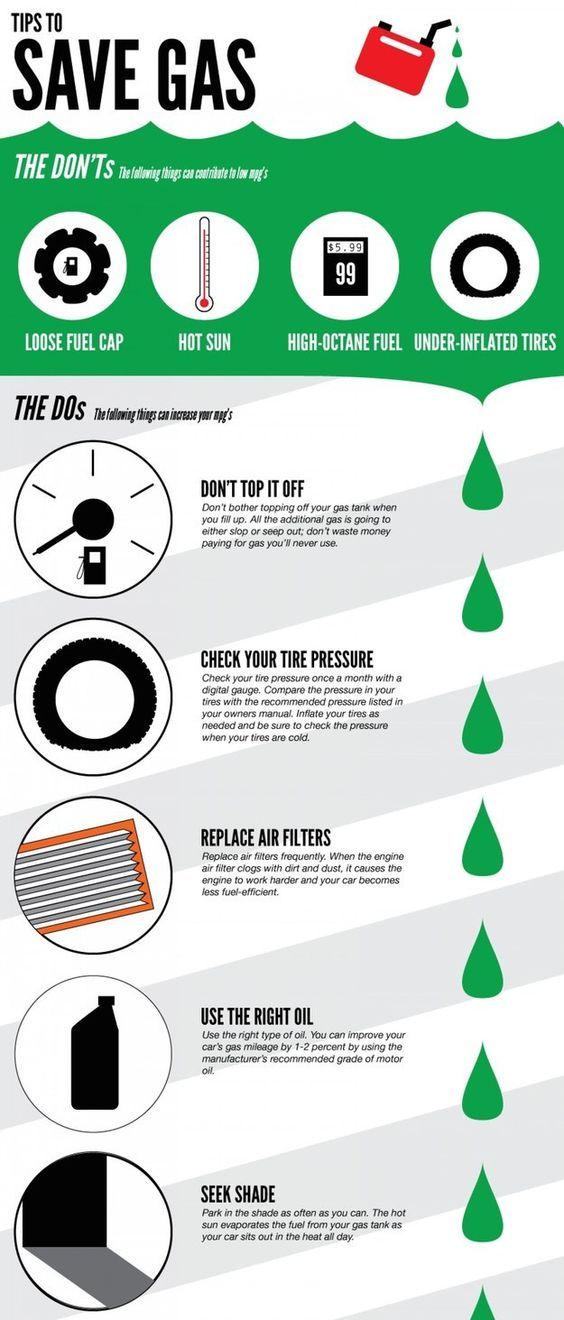
1120
113
11503
114
1180
115
1215
116
12503
117
1285
118
1320 9000 9000 9000 9000 9000 9000 9000 9000 9000 9000 9000 9000 9000 9000 9000 9000 9000 9000 9000 9000 9000 9000 9000 9000 9000 9000 9000 9000 9000 9000 9000 9000 9000 9000 9000 9000 9000 9000 9000 9000 9000 9000 9000 9000 9000 9000 9000 9000 9000 9000 9000 9000 9000 9000 9000 9000 9000 9000 9000 9000 9000 9000 9000 9000 9000 9000 9000 9000 9000 9000 9000 9000 9000 9000 9000 9000 9000 9000 9000 9000 9000 9000 9000 9000 9000 9000 9000 9000 9000 9000 9000 9000 9000 9000 9000 9000,000
121
1450
122
1500
| Load index | Weight per tire, kg | Load index | Weight per tire, kg | Load index | Weight per tire, kg |
|---|---|---|---|---|---|
| 62 | 265 | 83 | 487 | 104 | 900 |
| 63 | 272 | 84 | 500 | 105 | 925 |
| 64 | 280 | 85 | 515 | 106 | 950 |
| 65 | 290 | 86 | 530 | 107 | 975 |
| 66 | 300 | 87 | 545 | 108 | 1000 |
| 67 | 307 | 88 | 560 | 109 | 1030 |
| 68 | 315 | 89 | 580 | 110 | 1060 |
| 69 | 325 | 90 | 600 | 111 | 1090 |
| 70 | 335 | 91 | 615 | 112 | 1120 |
| 71 | 345 | 92 | 630 | 113 | 1150 |
| 72 | 355 | 93 | 650 | 114 | 1180 |
| 73 | 365 | 94 | 670 | 115 | 1215 |
| 74 | 375 | 95 | 690 | 116 | 1250 |
| 75 | 387 | 96 | 710 | 117 | 1285 |
| 76 | 400 | 97 | 730 | 118 | 1320 |
| 77 | 412 | 98 | 750 | 119 | 1360 |
| 78 | 425 | 99 | 775 | 120 | 1400 |
| 79 | 437 | 100 | 800 | 121 | 1450 |
| 80 | 450 | 101 | 825 | 122 | 1500 |
| 81 | 462 | 102 | 850 | 123 | 1550 |
| 82 | 475 | 103 | 875 | 124 | 1600 |
Pressure index is another name for the load index.
Euro label. Manufacturers put special stickers on tires. They have three parameters that are not written about on the bus itself. These stickers appeared in 2012. Since then, they have been on any tire sold in the EU.
The sticker complies with EC Regulation 1222/2009. This is a complex document with formulas and parameters like rolling resistance - it does not have the usual values like fuel consumption or braking distances. The sticker describes the tire according to three characteristics: noise level, fuel economy class and wet grip class.
/top-economic-cars/
11 economical cars for everyday driving
Noise level shows the noise level in decibels. One black sound wave is 3 or more decibels below the 2016 European norm. Two waves - at the normal level or quieter, but less than 3 decibels. Three - noisy tire, out of limit.
Fuel economy class. A is the most economical.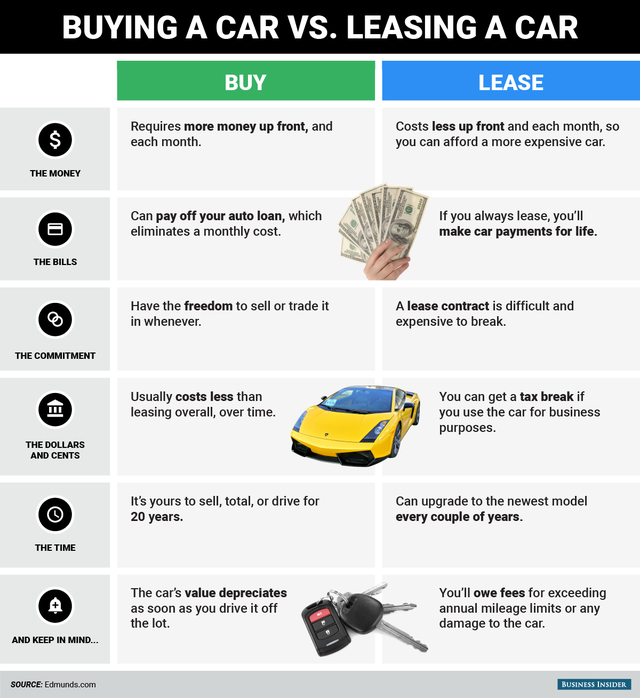 The lower the class, the more the tire resists rolling and the higher the fuel consumption. There is a 7.5% difference in fuel consumption between the most economical class A tire and the most "wasteful" class G. That is, for an average car with a consumption of 10 liters per 100 km and an annual mileage of 25,000 km, class A tires will save up to 187 liters of fuel - 8000 R.
The lower the class, the more the tire resists rolling and the higher the fuel consumption. There is a 7.5% difference in fuel consumption between the most economical class A tire and the most "wasteful" class G. That is, for an average car with a consumption of 10 liters per 100 km and an annual mileage of 25,000 km, class A tires will save up to 187 liters of fuel - 8000 R.
Grip. Same letters, but without color indication. This estimate was obtained when checking the braking distance on asphalt. The shorter the stopping distance, the closer the letter is to the beginning of the alphabet. The difference between A and G is more than 18 meters: A is the minimum stopping distance, B is plus 3 meters to A, C is plus 7 meters to A, D is plus 10 meters to A, E is plus 12 meters to A, F is plus 18 meters to A.
Sticker on a new tire Color markers on tires. There are another colored stripes on the tire tread - these are technological marks, they are of no use to the buyer.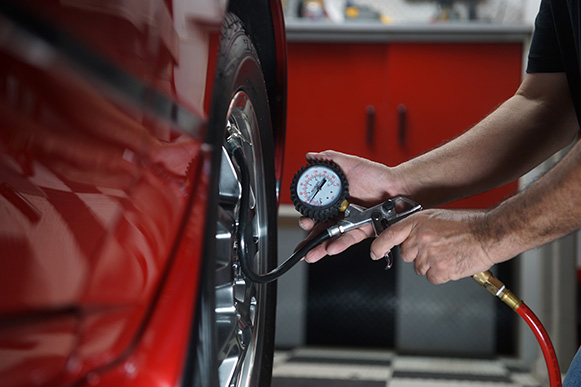 These drawings guide the production line, and they can also show the batch and release date.
These drawings guide the production line, and they can also show the batch and release date.
The most pedantic car owners may try to buy a set of new tires with identical stripes, but it is better to focus on the stamp with the release date on the sidewall.
Features of the choice of all-weather tires. Theoretically, they can be ridden all year round. The rubber compound works in the temperature range from -7 to +15 °C. In severe frosts, rubber hardens like summer tires at temperatures below +10 °C, and in hot weather it becomes softer, like winter tires at temperatures above +7 °C. In any case, all-season tires are not suitable for either hot asphalt or ice ruts.
All-season tires are chosen when they want to save on tire fitting and buying an extra set of tires. This is true for crossovers and SUVs with relatively low annual mileage.
Features of the choice of summer tires.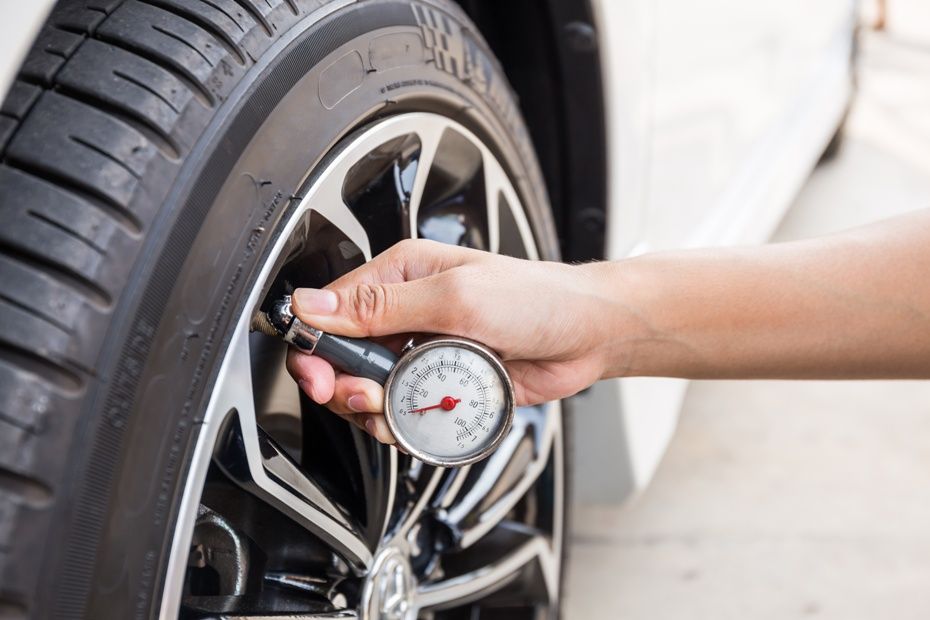 There are models for quiet city driving. Such tires will help save fuel, please with a low noise level and will last three to four seasons. At the same time, they will not tolerate overheating, will not provide perfect grip on the road and will not allow you to drive a car with great comfort.
There are models for quiet city driving. Such tires will help save fuel, please with a low noise level and will last three to four seasons. At the same time, they will not tolerate overheating, will not provide perfect grip on the road and will not allow you to drive a car with great comfort.
The opposite - tires for those who like to push the gas to the floor. Such tires will make noise, increase fuel consumption and wear out in one or two seasons. In return, the driver will get excellent grip and driving pleasure.
Features of the choice of winter tires. There are three types of winter tires.
The studded tires are good for driving on ice and packed snow. They have relatively hard rubber, deep tread and studs. And they also hold the road well on asphalt: the spikes have been hidden in the tread for a long time.
Ideal conditions - ice cover above -15°C. The ice is soft enough for the spikes to grip most effectively.
Disadvantages: they are very noisy, they have a low speed index. Usually, you can drive on studded tires no faster than 160-180 km/h. And they are also banned in many European countries because they spoil the asphalt.
Scandinavian type friction tires, aka Velcro, without studs and made for harsh winters. Rough tread pattern, soft rubber compound and many sipes - horizontal slots on the islands of the tire tread.
Ideal conditions are snow and ice below -15°C. They are noticeably quieter, you can move at a much higher speed on them.
Disadvantages: such tires wear out quickly, almost do not hold the car on melted smooth ice at temperatures above -5 °C. There is a small distance between the tread islands, such tires do not drain water well from the contact patch with the roadway.
Alpine type friction tires without studs and made for mild winters. There are 1.5-2 times fewer sipes on the tread, the grooves for water drainage are much wider. This is the most wear resistant winter tire.
This is the most wear resistant winter tire.
Ideal conditions - puddles, asphalt, -5 to +3 °C. Well remove water from the contact patch with the roadway.
Disadvantages: poor grip on any ice and packed snow.
According to the Rules of the Road, different tires cannot be put on one axle of a vehicle. This is considered a malfunction in which the use of a car is prohibited.
p. 5 of the Traffic Regulations of the Russian Federation: wheels and tires
At the same time, the rules do not prohibit installing tires of different brands and models on different axles of the same car, but it’s better not to do this. The car and all its systems are designed for the same tires with the same grip.
This is especially true for modern cars with many electronic assistants: stabilization systems, brake force distribution. You can drive on such a combination of tires, but no one knows how the car will behave in an extreme situation.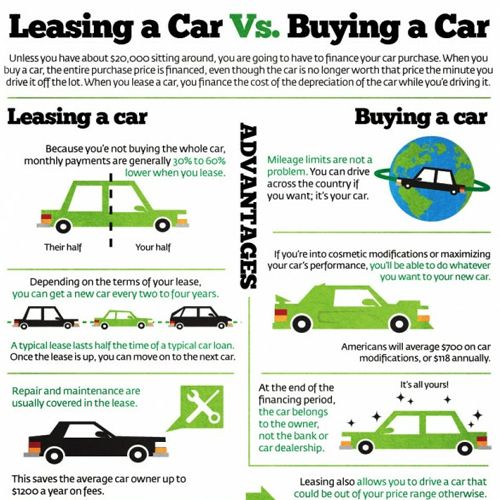
Like everywhere else, there are premium brands and there is something cheap. But cool brands have failed models, while budget brands have successful ones.
There is a lot of research and testing behind famous brand tires. Before entering the market, large companies test each new model in the most extreme conditions. Tires can be rolled on arctic ranges or in the desert.
Often, rubber is tested in the conditions of sports competitions and only then the technology is sent to the mass market. The more famous the manufacturer and the more expensive its products, the greater its budget for the development of new models.
There are also very cheap tires, often from China. They can directly write that they copied the tread pattern of a prestigious model, but this is not enough: there is also a rubber composition, cord design and other parameters.
Prices for tires of the same size may differ by multiples. The smaller the profile and the larger the width, the greater the difference.
To look at something other than the brand and choose what you need, there is an algorithm:
Specialized shops. There is a large selection, catalogs of manufacturers and competent advice. This will appeal to those who buy car tires for the first time or are simply not very interested in the technical side of cars. There is a service here - there will be a guarantee for tires, there is tire fitting and seasonal storage. The one-stop principle works: you can arrive on spikes and leave on a new summer and with an empty trunk.
The one-stop principle works: you can arrive on spikes and leave on a new summer and with an empty trunk.
Online hypermarkets and warehouses. Rubber is sold by large Internet sites and small shops. The option is suitable for those who want to find cheaper, are ready to take risks and waste time for this. Here, the entire responsibility for checking the parameters of the tire, the date of its release and, in general, compliance with the order lies with the buyer. If something goes wrong, you will have to take all four tires to no one knows where and change them. Tire fitting and storage is the buyer's concern.
/save/mashina-hack/
How to save on car maintenance?
Flea markets, car club forums and ad services. Avito, Yulia and specialized automotive forums offer a lot of rubber. You can buy a completely fresh set at a good price, or you can buy rubbish and expensive. There is a great risk of buying tires with hidden damage: the fact that the tire is crooked will only be opened at a tire fitting, many hernias will be visible only on an inflated tire.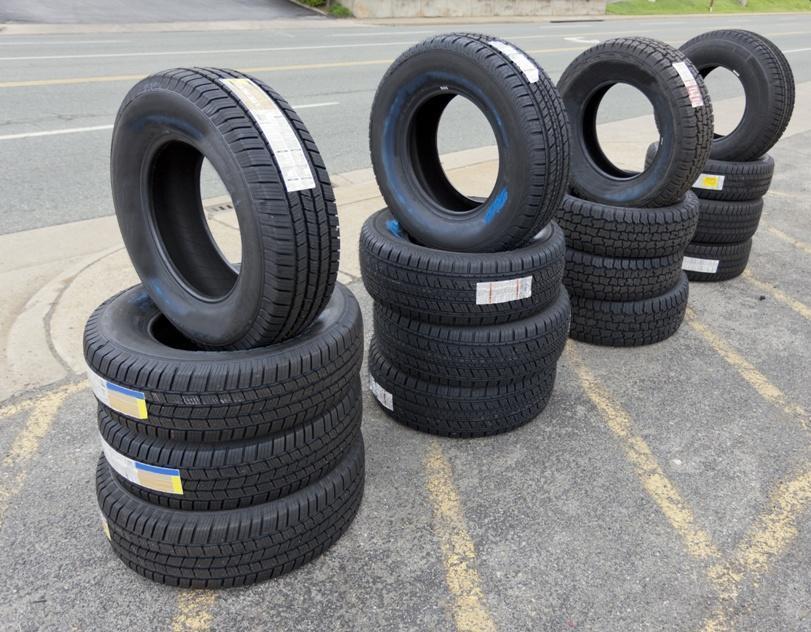
Sometimes the ability to measure depth and read parameters does not help. To put the correct year on an old tire, there is a special stamp. The tread depth can be machined, and a tire that is white from old age can be treated with ink.
With the help of special equipment, you can even remove the remnants of the old protector and stick a new one. It remains to hope for the reputation of the seller and look at the goods that he sells or sold. I try to avoid those who sell used rubber all the time.
First of all, the size. The larger the diameter, the more expensive. But at the same time, the lower the tire profile, the more expensive it is. This may seem counterintuitive, as less material is used.
Tire inner layers and construction play an important role. Due to the low profile height, the sidewall of such a tire must be much stronger than the same tire with a high profile.
Tire make and model affected. Rubber from large, famous brands with a century of history is more expensive, but the budget lines of well-known companies will allow you to save a lot. Tires of young, unknown manufacturers, especially Asian ones, will cost even less.
Tires of young, unknown manufacturers, especially Asian ones, will cost even less.
Tires with runflat technology are more expensive than conventional tires, because their sidewalls have special requirements.
Is it worth buying retreaded tires? It is almost impossible to buy such tires for a passenger car in Russia in 2021. The cord design of car tires for projector restoration is not intended, unlike truck tires, for which this is a very popular service. In some countries in Eastern Europe, you can buy retreaded tires in popular sizes, but their properties are mediocre: long braking distances, poor handling.
When is the best time to buy tires? The popular theory that tires are best bought between seasons is no longer valid. You won’t be able to save money this way: the price of tires almost does not change throughout the year.
The tire business is seasonally cyclical, and it is not worth hoping for discounts on studded tires and its wide selection in June. For the next winter season, it will be delivered in August, and summer tires in March.
For the next winter season, it will be delivered in August, and summer tires in March.
But by the season, the freshest tires will be on sale. This is true for those who drive very little, or for sports tires. The fresher the tire, the better the grip will be: the rubber compound loses its properties over time.
Always make sure that your tire pressure is correct: it is critical to tire health. If you lose pressure, do not continue driving on an empty wheel: this may destroy the tire.
Try not to store tires and the car within half a meter of heaters.
Old tires cannot simply be thrown in the trash or buried. This is hazard class 4 waste, they must be disposed of.
GOST 12.1.007-76
Tires can be sold on Avito or other ad service. It will turn out if there is no serious damage and the tread depth allows them to be used further.
Old tires are readily picked up by a tire shop.